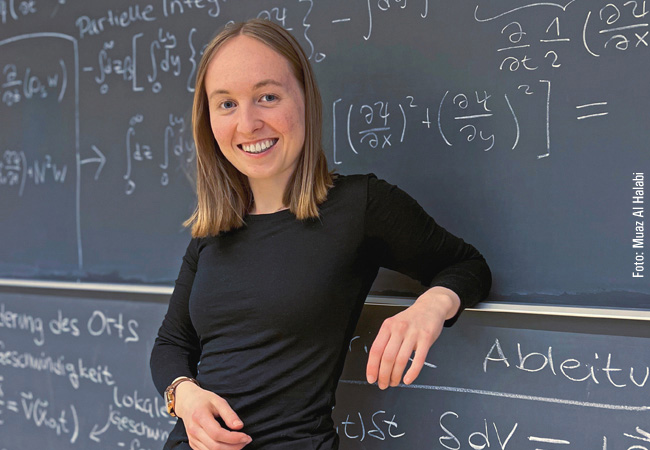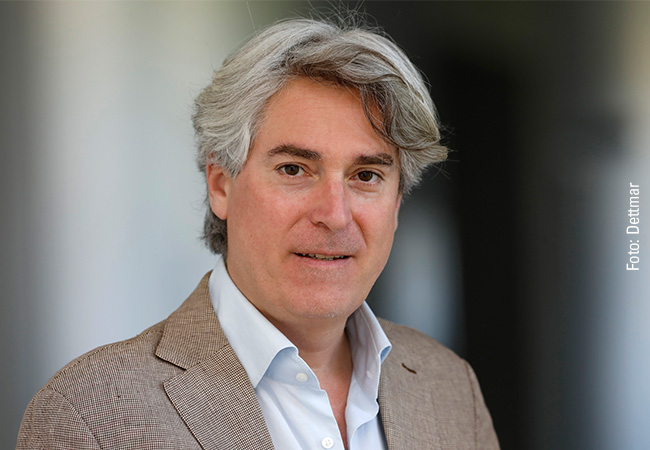Computer scientists Uwe Brinkschulte and Mathias Pacher are working on secure and self-organizing drone systems based on organic computing.

Architecture of the artificial DNA system in a drone swarm.
Drones have been affordable for hobby users for some years now. Today it has become child’s play to have them take aerial pictures, including of one’s own living quarters. However, the popularity of drones also generates questions about cybersecurity in both the private and the professional spheres. “Drones can be attacked in very different ways. Information is transmitted to the devices either via Wi-Fi or Bluetooth, which makes them relatively easy prey for hackers,” explains Uwe Brinkschulte, Professor of Embedded Systems at Goethe University Frankfurt’s Institute of Computer Science. How can this technology, which is also popular among state authorities, be made more secure? Brinkschulte and his colleague, Associate Professor Mathias Pacher, are working on the development of organic computing. Brinkschulte explains: “The developers aren’t able to handle the growing complexity of hundreds of processors on one chip, nor can they really exploit their potentials. One possible solution, the idea of which has already been around for 20 years, is to use biology as a model for designing new computer systems to make them more resilient to failures and enable them to adapt to new surroundings by themselves. This is particularly important in the case of so-called embedded systems, which are integrated into a technical environment for control purposes.” This particular branch of computer science is called organic computing. Such robust organic computing systems can then be deployed, among others, to control a drone or a swarm of drones.
Organic computing systems are designed like biological units, and possess a series of useful characteristics: They are able to organize, configure and optimize themselves, for instance. “Such a system, which is based on biological systems, independently finds the starting configuration and can optimize and adapt itself to the prevailing environmental conditions. It is also able to ‘heal’ itself, like a wounded living organism. To illustrate what exactly organic computing is about, we built a small vehicle that stands on two wheels like a Segway, and continuously has to adjust its balance. If we deactivate individual processors in the vehicle, it can compensate for this kind of loss, even if it’s a bit wobbly at first,” Brinkschulte explains. He compares this to the stability of the heart: If individual muscle cells fail, others compensate for them, and the heart will continue beating. Another important property of this type of system is self-protection. Connected systems are particularly susceptible to external attacks and must therefore detect a threat in time and recognize what kind of threat it is. The principle of self-explanation means the system must be able to explain to the user what exactly has changed. Finally, self-awareness also means that the system knows its own abilities.
Modeled after the human hormone system
At this point, Brinkschulte stresses that the concept of self-awareness is in no way related to that of human self-awareness. “It’s a technical system and not a biological one. What we want to do is transfer the properties of a cell to a chip, so to speak. In so doing, we took the human hormone system – a decentralized control circuit – as a guide. When cells or glands secrete hormones, they either accelerate the system or slow it down.” The control circuit is completely decentralized and consists of a large number of interacting cells that can also fail from time to time. The artificial hormone system is flexible, self-organizing and fault-tolerant. As soon as a computing node has assumed a task, it issues a corresponding inhibiting hormone. If this node fails at some stage, the inhibiting hormone can no longer be issued, and another computing node takes over immediately.
“We based the design of an artificial hormone system on real biology. So the question is: How are organs formed in a living creature? In principle, stem cells can assume any function. If a cell develops into a liver cell, for example, it secretes hormones so that similar cells will develop in its vicinity. The DNA is the blueprint that specifies how the organism is built up.” Brinkschulte adds that such blueprints also can be used in computer science. The artificial DNA basically is an abstract blueprint for the system. “You could say that each computing node contains the complete blueprint, while the artificial hormone system ensures that this plan is followed precisely. In case of a disruption, the plan constructs itself again – it repairs itself automatically – and the tasks are redistributed to other computing nodes. That’s the basic idea of our design.”
In-flight processor failure
How exactly is the artificial DNA system deployed in a drone? Like Brinkschulte, associate professor Pacher is an expert in embedded systems. He explains the mechanism: “The DNA processors are installed either in the drone or in the base station. The processor can control a single drone, or a whole swarm of drones. As part of our project, we are working together closely with the Hessian Police Flying Squadron, which places specific requirements on the deployment of drones. As such, sometimes crowds of human beings have to be monitored using several drones. In such instances, the drones need to spread out in a circle – something that is relatively easy to do when using our technology.” Pacher emphasizes that to avoid accidents, in the early stages, the work consists mostly of simulations. By now, however, a real drone has been deployed without incident. Pacher and Brinkschulte are investigating how the drones cope with processor failures, although Pacher also points out that, “We can use the artificial DNA system to remedy disruptions in the software, but we can’t do anything about a mechanical fault such as a rotor coming off.” For the police it is important for the communication between the base station and the drone to function perfectly. Data theft or active intervention in the system by an external drone are risks that must be prevented. “One security measure is to encrypt the artificial hormones. In addition, the processors must be able to recognize whether the incoming message is integer or not. We’re also working on a trust mechanism that’s familiar from social contexts. The drones build up trust with one another based on observations. If trust exists, they will also assume tasks for one another.”
Some people might think the idea of a self-organizing and self-healing drone sounds like science fiction. Could the drones theoretically break free from human control and develop a life of their own that could endanger ours? “Not with our blueprint. The drone cannot override the preprogrammed control,” Brinkschulte stresses. “There are also a large number of potential civilian uses. As such, drone swarms are already being used today to replace real fireworks, or to create light shows. Our technology could help deal with gusts of wind and other disturbances by using drones programmed to react appropriately.”
Another indicator for the future usefulness of artificial DNA is the fact that research on the topic is currently being undertaken in many other directions: As such, the scientists in Brinkschulte and Pacher’s group are cooperating with partners in industry and research on integrating the DNA system into the steering control of an autonomous vehicle and expanding the system to enable changes to the DNA during run-time.
More about the German Research Foundation’s (Deutsche Forschungsgemeinschaft, DFG) project Organic Computing with Artificial DNA for Reliable Dynamic Systems based on Semantic Models and Evolutionary Algorithms for Fault Diagnosis and Adaptation.













